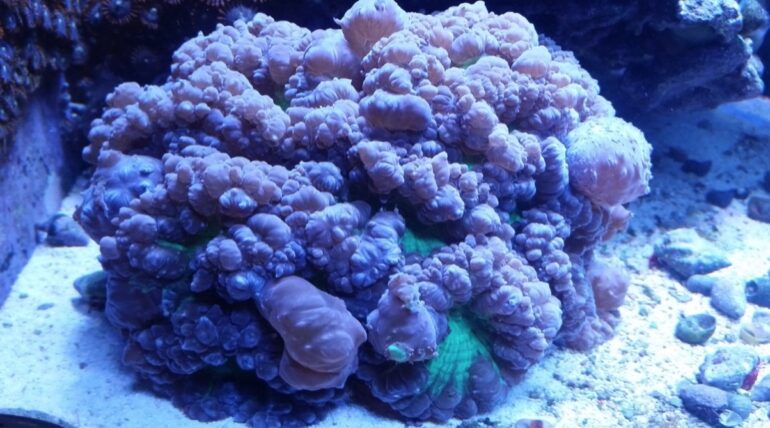This story starts with Joe Caparatta, years before he joined Unique Corals. At the time Joe was running a company called New York Aquarium Services in midtown Manhattan. A company I owned became one of his clients and about ten years ago Joe sold me a gorgeous pink and green Blastomussa coral colony.
I was just getting started in the hobby, and a few weeks later I placed a new Galaxea coral not far from the Blasto, and at the same time added a new power head to boost the flow in the tank. Well, a few days later I came into work to see the Galaxea just utterly annihilating this poor Blasto colony (with sweeper tentacles). Needless to say, the Blastomussa colony was never the same.

What happened next is where this story gets interesting. After half of the Blasto colony died off, the remaining polyps developed what at the time I considered to be a deformity: big bubbles started forming around many of the surviving polyps. And to be completely honest, the coral looked strange and ugly. However over the past decade, this coral has redeveloped a lot of its lost tissue, and become one of the most interesting pieces I have ever seen in my life.
What I have come to learn is that the attacked triggered a defense mechanism (or perhaps a series of defense mechanisms) in this coral colony which resulted in genetic mutation. While this may be somewhat common in the ocean, I have been told that this is quite uncommon in an aquarium.

How do we know it’s a genetic mutation? Well, I didn’t at first. But something remarkable happened over the past year. Last fall, I found a single polyp of this coral just sitting in the sand on its own. Assuming that it just fell off (I later came to learn that the colony ejected the polyp), I grabbed the frag glue and connected it to a little rock chip. Nine months later this single little polyp has turned into a baseball sized mini colony of its own.
So what does all this have to do with genetics? Well, up until this point, absolutely nothing. But a few months ago the mini colony began to develop the very same bubbles as the mother colony. The only explanation anyone has since been able to provide is that the DNA of the coral mutated in my tank.


So why call it a Bounce Blasto? Is it just because of the bubbles? Not really. It’s why the bubbles formed in the first place that makes the Bounce Blasto somewhat similar to the Bounce Mushroom, but even more remarkable. From what I have come to understand, Bounce Mushrooms are really just deep water mushrooms which are exposed to strong LED or Halide lights for the first time and develop bubbles as a defense mechanism in response to the strong lights.
They apparently mutate from one thing to another as a defense mechanism to adverse conditions – in this case much more light than they are used to receiving. Similarly, the Bounce Blasto has mutated from one thing to another as a defense mechanism to adverse conditions – in its case a sting that almost killed it.

At Reef-a-Palooza this year in New York, I saw Joe Caparatta for the first time in years and showed him pictures of his old Blasto colony and explained what had happened. Joe explained that this was one of the most amazing things he had ever seen occur to a coral in captivity.

The wide world of soft and stony corals is full of amazing phenomenon happening in our tanks all the time. Huge thanks to Larry Footer for contributing his story about this anomalous Blastomussa colony appearing to exhibit ‘epigenetic’ changes to its appearance and shape.



